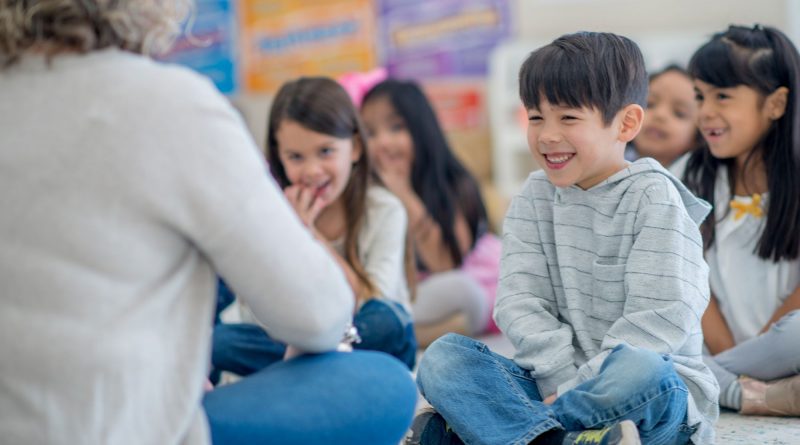Building a Joyful Classroom Community
In a year full of uncertainty and stress, teachers in the early grades can create a safe and even joyful learning environment.
As teachers, we are experiencing anxiety, disruptions, and uncertainty because of the lingering pandemic. However, happiness can still happen behind our closed classroom doors. This year, I’ve worked hard to make my classroom a happy place for my students, who come to class looking for some sense of normalcy in an otherwise chaotic world.
I ask myself the following questions: What are my students’ favorite activities? What draws the most engagement in the classroom? What can I do to make these occurrences more frequent?
These are the places I have seen joy emerge, and providing more opportunities for this to happen helps me keep going and stay focused on the essential part of my job this year—creating a safe environment where students can find joy in learning even in challenging times.
Build a Strong Community
Being a part of a powerful community allows students to see school as a safe, caring environment and provides support as together we navigate the unknown.
To give an example, I start the day by placing materials such as Legos, drawing paper, and books on tables for my students to choose from as they arrive, allowing them to talk casually and connect with their peers. Then, at our morning meeting, we form a circle and I ask them, “How are you feeling?”
The kids and I sit in silence for a moment, waiting for each other to respond. “I’m overwhelmed,” “I’m exhausted,” “I’m scared,” “I’m very happy to be here,” “I enjoy going to school,” and “I’m feeling all mixed up inside” are among my students’ responses. Sometimes we share some fabulous (or not-so-fabulous) news.
We reassemble for quiet time in the middle of the day. I turn on soft lights as we do a guided meditation to help us refocus and center ourselves. While the kids rest, draw, or read, soft music plays. This sets the tone for a calm afternoon.
We turn on a dance song and sing along to our favorite songs during transitions throughout the day and to add fun to our routine as we clean up the room.
We reassemble in our circle before school ends for the day. I ask each child to describe the day in one word, whether it be a feeling, an accomplishment, or a favorite activity.
These moments unite us as a happy community that looks out for each other, laughs together, takes deep breaths, and reflects on what we are doing together as a class.
Engage in Authentic Curriculum
For years, I’ve taught my students about animal adaptations by comparing various types of bears, which is a popular animal among them. On one of our outdoor learning days this year, my students stumbled upon a porcupine den in the woods behind our school. It piqued their interest, which showed up in their drawings, block constructions, and story writing.
“Everyone acknowledges that curriculum becomes intriguing, alive, and compelling when something out of the blue captures the imagination of a group of children,” David Sobel wrote in his book Childhood and Nature. Their newfound interest inspired me to change course.
In this year’s science unit, we are studying the adaptations of our local porcupine family. To learn more, we brought in a local naturalist. She brought in a real porcupine skull for the kids to see, quills for them to feel, stories about porcupines in the wild, and books to help us all learn more.
We brainstormed important questions the children had using the Question Formulation Technique, which we will use to guide our research. We used online resources to find more books and videos to aid us in our research and nonfiction writing. As a final project, each child will write a chapter book explaining the animal’s survival adaptations.
As a culminating project, we will collaborate with the art teacher to create an artistic representation of the den on a bulletin board, to which the children add information gleaned from the experience. The project keeps growing, and the excitement builds with each new idea that emerges. We invite parents to take part in our class project by posting updates on our classroom blog for them to follow.
This all started with the kids and their excitement because of a discovery we made as a class. Focusing on activities that encourage children’s happiness, curiosity, and engagement—or even making the tiniest change in the curriculum to a topic that matches their interests—can sometimes pave the way for happiness.
Share Student Voices
In these times of uncertainty, we all need a place to be seen and heard. This happens in my class during Writer’s Workshop. Every day, children find a quiet corner of the room to write in, where they create stories about things that matter to them. They write about everything, then draw colorful pictures to go along with their words.
Then comes the most exciting part. Returning to the rug, the children discuss their work with a friend. They enjoy getting together to read aloud to one another. During sharing time, the room is quiet, but the laughter is loud as they read their stories.
We form a circle and project a few stories onto the document camera so that the entire class can see and discuss them. The author then walks to the “Author’s Chair” to receive questions, comments, and compliments on their story from their peers.
One of my students recently wrote a story about how happy she was to receive her Covid shot. “I jumped up and down because I love my covid shot. I got it at school. When it happened, I wasn’t crying. My dad was so proud!” she wrote. She recalled the night we converted our school gymnasium into a vaccination center, with children and parents waiting in long lines for hours to get their shots.
When we get together as writers, we can share these experiences and support one another through the various emotions they bring out in us.
“The happiness of the child is one test of the correctness of educational procedure,” Maria Montessori once said. So, right now, do more of the things that make your students happy.
We all need more of that.
Source: https://www.edutopia.org/article/building-joyful-classroom-community




